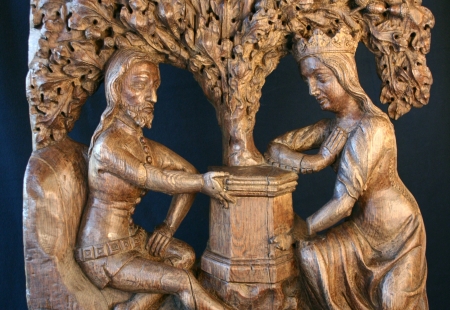"Slaves of Love" on the benches in the Town Hall
The oldest bench in the Council Chamber is the lower one. It was made in the 14thcentury for the Council Chamber, which was located on the first floor in those days. In the Town Hall account book, there are two entries about the bench from the years 1363-1374: 1 mark was paid to the carpenter[1] for making this bench, and 16 öres were paid to the woodcarver [2]. Consequently, we can assume that the benches were made on the spot in Tallinn, and it is possible that they were produced by local craftsmen. On one side of the bench, the meeting of Tristan and Isolde under the tree is carved out exquisitely, while opposite one can see Samson fighting the lion.
When the new floor was completed in 1404, the old bench was moved to the new Council Chamber upstairs. Another, taller bench was made for the burgomasters. It is decorated with the images of Samson and Delilah and Aristotle and Phyllis on the one side and with David and Goliath together with the lion and the bear on the other side.
Together those two benches form an ideal integral whole in the hall where they are situated. The images on them express the beliefs of the council and their contemporaries and they were carved to reflect the latest style. The councillors, all of whom were successful Hanseatic merchants, used the images they had seen on their trading trips to the cities of western Europe as examples. The Hanseatic League was not just a sphere of trading, but also a common cultural space. These links facilitated the rapid inflow of the latest European cultural and stylistic trends to Tallinn.
In modern European art history, the benches in Tallinn’s Town Hall are not at all well-known, since after World War II Estonia disappeared from the world map and art researchers of Western Europe could not travel behind the Iron Curtain. For example, one of the most detailed lists of depictions of Tristan in art, which was published in Munich in 1975 (“Katalog der Tristan-Bildzeugnisse”, Norbert Ott), erroneously claims that the Town Hall bench with Tristan and Isolde in Tallinn was destroyed during the war. Of course World War II is implied here, when many buildings in the Old Town, including the buildings in close vicinity to the Town Hall, were destroyed as the result of an air offensive by Soviet troops in 1944. However, not much damage was done to the Town Hall itself. Since the list in question has served as the basis of study for many Western art researchers, the images of Tristan and Isolde in Tallinn were overlooked by them, too.
The confusion is increased by the fact that until 1918, Tallinn was named Reval. For example, the most detailed list of artworks depicting Aristotle and Phyllis, available in the German-language Wikipedia, erroneously categorizes the sculpture of this couple from Tallinn’s Town Hall as being located in Germany, under the name Reval.
[1] About ¼ of the annual salary of a Town Hall servant in the 14th century
[2] 16 öres = 1/3 marks. For this amount, you could buy a barrel of the best ale or half of a bull in the 14th century




